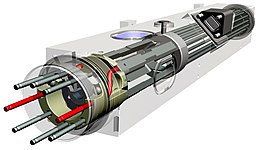 The miniaturized Deep Space Atomic Clock was designed for precise and real-time radio navigation in deep space. | |
| Mission type | Navigation aid in deep space, gravity and occultation science |
|---|---|
| Operator | Jet Propulsion Laboratory / NASA |
| COSPAR ID | 2019-036C |
| SATCAT no. | 44341 |
| Website | www |
| Mission duration | Planned: 1 year[1] Final: 2 years and 26 days |
| Spacecraft properties | |
| Spacecraft | Orbital Test Bed (OTB) |
| Manufacturer | General Atomics Electromagnetic Systems |
| Payload mass | 17.5 kg |
| Dimensions | 29 × 26 × 23 cm (11 × 10 × 9 in) |
| Power | 44 watts |
| Start of mission | |
| Launch date | 25 June 2019, 06:30:00 UTC[2] |
| Rocket | Falcon Heavy |
| Launch site | KSC, LC-39A |
| Contractor | SpaceX |
| Entered service | 23 August 2019 |
| End of mission | |
| Disposal | Deactivated |
| Deactivated | 18 September 2021 |
| Orbital parameters | |
| Reference system | Geocentric orbit |
| Regime | Low Earth orbit |
| Epoch | 25 June 2019 |
The Deep Space Atomic Clock (DSAC) was a miniaturized, ultra-precise mercury-ion atomic clock for precise radio navigation in deep space. DSAC was designed to be orders of magnitude more stable than existing navigation clocks, with a drift of no more than 1 nanosecond in 10 days.[3] It is expected that a DSAC would incur no more than 1 microsecond of error in 10 years of operations.[4] Data from DSAC is expected to improve the precision of deep space navigation, and enable more efficient use of tracking networks. The project was managed by NASA's Jet Propulsion Laboratory and it was deployed as part of the U.S. Air Force's Space Test Program 2 (STP-2) mission aboard a SpaceX Falcon Heavy rocket on 25 June 2019.[2]
The Deep Space Atomic Clock was activated on 23 August 2019.[5] Following a mission extension in June 2020,[6] DSAC was deactivated on 18 September 2021 after two years in operation.[7]
- ^ "Deep Space Atomic Clock (DSAC)". NASA's Space Technology Mission Directorate. 20 May 2015. Retrieved 10 December 2018.
 This article incorporates text from this source, which is in the public domain.
This article incorporates text from this source, which is in the public domain.
- ^ a b Sempsrott, Danielle (25 June 2019). "NASA's Deep Space Atomic Clock Deploys". NASA. Retrieved 29 June 2020.
 This article incorporates text from this source, which is in the public domain.
This article incorporates text from this source, which is in the public domain.
- ^ Boen, Brooke (16 January 2015). "Deep Space Atomic Clock (DSAC)". NASA/JPL-Caltech. Archived from the original on 11 November 2020. Retrieved 28 October 2015.
 This article incorporates text from this source, which is in the public domain.
This article incorporates text from this source, which is in the public domain.
- ^ "Deep Space Atomic Clock" (PDF). NASA. 2014. Retrieved 27 October 2015.
 This article incorporates text from this source, which is in the public domain.
This article incorporates text from this source, which is in the public domain.
- ^ Samuelson, Anelle (26 August 2019). "NASA Activates Deep Space Atomic Clock". NASA. Retrieved 26 August 2019.
 This article incorporates text from this source, which is in the public domain.
This article incorporates text from this source, which is in the public domain.
- ^ "NASA Extends Deep Space Atomic Clock Mission". NASA/JPL-Caltech. 24 June 2020. Retrieved 29 June 2020.
 This article incorporates text from this source, which is in the public domain.
This article incorporates text from this source, which is in the public domain.
- ^ O'Neill, Ian J. (5 October 2021). "Working Overtime: NASA's Deep Space Atomic Clock Completes Mission". NASA. Retrieved 5 October 2021.